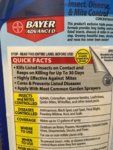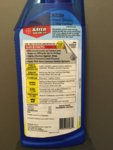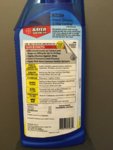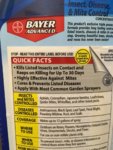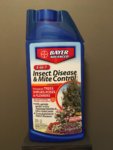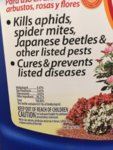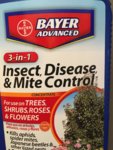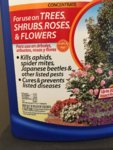I have a few indoor bonsai like Flowering Fukien Tea and some others. The Fukien defoliated about 85% about a month ago (I think that is normal for fall winter with this plant) and since then has been producing lots of new growth and leaves. Yesterday I noticed it was not looking as vibrant and I was loosing new growth leaves also. Took a look with a magnifying glass and see those tiny (really tiny) white spider mites on the underside of the leaves. I sprayed the tree with Bayer 3 in one as this is all I had on hand. During the summer months here I fight spider mites continually in the later part of the summer and fall. They attack my Dahalias, Zinnias, and a number of shrubs in the yard. To my knowledge I have never had the mites on conifers or evergreens. I know that my yard seems to be different than the one 2 blocks away that never has mites and I don't know why. I have removed shrubs from the yard that seem to always get the mites. In the past I have sprayed with the Bayer 3 in 1, that is supposed to be a systemic miticide, and not had good luck. I now am going to have a number on Bonsai's, both Conifers and deciduous and would like to find something that will work, like maybe a systemic that one puts on 3X per year and it actually works. I watched and listened to videos on the subject, but am thinking you folks might have the best answers for this problem. Help appreciated. Thanks, Peter
You are using an out of date browser. It may not display this or other websites correctly.
You should upgrade or use an alternative browser.
You should upgrade or use an alternative browser.
spider mite control
- Thread starter August44
- Start date
coachspinks
Chumono
Where are your indoor bonsai being kept? Greenhouse or under grow lights in your home?
coh
Imperial Masterpiece
Spray the plant with a hard stream of water every day. Take it to the sink or bath tub and let it have it. Spray everything, including under the leaves.
Knock them off.
I've had mites attack a few plants and have never had to resort to harsh chemicals, have always been able to control/eliminate just using water.
Knock them off.
I've had mites attack a few plants and have never had to resort to harsh chemicals, have always been able to control/eliminate just using water.
Wires_Guy_wires
Imperial Masterpiece
If they strike, which is a rare occasion to begin with, treatment with neem oil seems to work just fine.
The spider mites around here are resistant to pyrethrins, so it's no use in using those.
Lukewarm water seems to work wonders as well. Just like the outdoors.
The spider mites around here are resistant to pyrethrins, so it's no use in using those.
Lukewarm water seems to work wonders as well. Just like the outdoors.
I have hated my F Tea since my sister gifted it to me 3yrs ago. Total pest magnet compared to my Ficus and Serissa and everything else. Sticky nasty tree. I have to keep it going out of respect or would have ditched it a year or two ago.
This spring I used Bayer Advanced 12 month for trees and shrubs. 1/3 teaspoon to a gallon and watered into pots. I was not so confident about using it and feared for my trees health. Amazing results! All my trees both in and outside trees have been pest free all year. I am working on the F Tea as we speak and it is as healthy and happy as ever, flowering everywhere, and not sticky like before. This was a single treatment 9 months ago. I'm sold and not such a F that Tea guy now.
This spring I used Bayer Advanced 12 month for trees and shrubs. 1/3 teaspoon to a gallon and watered into pots. I was not so confident about using it and feared for my trees health. Amazing results! All my trees both in and outside trees have been pest free all year. I am working on the F Tea as we speak and it is as healthy and happy as ever, flowering everywhere, and not sticky like before. This was a single treatment 9 months ago. I'm sold and not such a F that Tea guy now.
The Flowering Fukien Tea is in my house in front of a south facing window until summer when it will go outside again. What are those supposed to look like if they are big and pruned correctly? If someone has a picture (Underdog ??), that would be a help.
I sprayed the tree as soon as I saw that it had the mites with the Bayer 3 in one. Shake test the next day and no mites. I will spray again in 5-7 days to make sure. That spray says it will last 30 days, but I don't believe that...maybe it will.
Interesting about the Bayer Advanced 12 months for trees and shrubs Underdog. Did you just treat it once or several times? Does that work on conifers, maples etc?? Sounds like you've discovered something to me.
Thanks for all the input. Thank you for helping me. Peter
I sprayed the tree as soon as I saw that it had the mites with the Bayer 3 in one. Shake test the next day and no mites. I will spray again in 5-7 days to make sure. That spray says it will last 30 days, but I don't believe that...maybe it will.
Interesting about the Bayer Advanced 12 months for trees and shrubs Underdog. Did you just treat it once or several times? Does that work on conifers, maples etc?? Sounds like you've discovered something to me.
Thanks for all the input. Thank you for helping me. Peter
Only one treatment in spring. Had planned a second dose in fall but didn't. Used it on a few guinea pigs first then everything a couple weeks later after the pigs survived. Didn't use it on Blue Berry or anything you or birds will eat. This bottle will last a lifetime.
Attachments
I sprayed the tree as soon as I saw that it had the mites with the Bayer 3 in one. Shake test the next day and no mites. I will spray again in 5-7 days to make sure. That spray says it will last 30 days, but I don't believe that...maybe it will.
I would certainly follow up with at least one more spray as you mentioned. Also you should be able to get away with using horticultural oil if you prefer.
Mellos/Underdog...Thanks for the follow up and the pictures of the goods and the tree. Underdog, do you use that stuff on yard shrubs also? What's the dosage rate there if you do? Thanks, Peter
PS: can these critters get on you and bite? I have been itching for two days now
PS: can these critters get on you and bite? I have been itching for two days now
Last edited:
PS: can these critters get on you and bite? I have been itching for two days now
Not the same mites that are feeding on your plants.
bwaynef
Masterpiece
I've heard from more than one person that imidacloprid (Bayer 3-in-1, et al) doesn't kill spider mites and only serves to hasten their infestation. I think Neem has a compounding/cumulative effect on spider mites (from research rather than experience), and there are chemicals made specifically to treat mites in different stages. Its recommended to use at least 2 that treat different life cycles.
Wires_Guy_wires
Imperial Masterpiece
Mellos/Underdog...Thanks for the follow up and the pictures of the goods and the tree. Underdog, do you use that stuff on yard shrubs also? What's the dosage rate there if you do? Thanks, Peter
PS: can these critters get on you and bite? I have been itching for two days now
Have you used the product indoors? Did you wear protection? Did you stick to the instructions too? No need to answer me in public. Answer this to yourself and be honest to yourself about it. Act appropriately.
Allergic responses like these can happen when you use pesticides, they're a sign of poisoning. And yes, all components in Bayer 3-in-1 are toxic to humans in some way or another. If the itch is all over your body (systemic poisoning), contact your poison control center ASAP and don't forget to bring the label. If it's just your hands, then you should still make the call. Excuse me for hearing alarm bells, but I've seen this stuff in the past, and it didn't end well.
I'm seeing 'indoor plants' and 'pesticide use' and 'allergic response'. 1+1+1=3. It adds up. Maybe it's nothing and I'm just being dramatic, maybe its something serious that should be looked at.
amatbrewer
Shohin
I get spider mites really bad most years, but only outdoors. From a Wikipedia article "Hot, dry conditions are often associated with population build-up of spider mites." and Yakima is nothing if not hot and dry (cold and dry in the winter).
I have had success with a combination of neem oil and frequent rinsing of the foliage until they are gone.
I have had success with a combination of neem oil and frequent rinsing of the foliage until they are gone.
coh
Imperial Masterpiece
I've heard from more than one person that imidacloprid (Bayer 3-in-1, et al) doesn't kill spider mites and only serves to hasten their infestation. I think Neem has a compounding/cumulative effect on spider mites (from research rather than experience), and there are chemicals made specifically to treat mites in different stages. Its recommended to use at least 2 that treat different life cycles.
There have been studies that show that imidacloprid increases the reproductive rate of some spider mite species, for example
https://www.researchgate.net/public...ranychus_buxi_Acari_Tetranychidae_on_boxwoods
Leo in N E Illinois
The Professor
- Messages
- 11,427
- Reaction score
- 23,606
- USDA Zone
- 5b
Insecticides - a difficult topic. Remember, if mites as a general term or specific as spider mites, flat mites, 2 spot mites, etc are not listed on the label, then the pesticide will not kill them.
The really potent miticides are often quite expensive. I purchase chemicals from Hummert out of St Louis, they seem to be relatively lax about requiring copies of pesticide applicator licenses. Some states will not let you purchase what Missouri seems to allow.
http://www.hummert.com
Go to chemicals section, you will find listings for miticides and insecticides mixed on the same page. You will have to read the on line labels of each to decide what is right for you. Look for dose rates, often a really expensive pesticide might work out for you because the cost per application is low.
Some of the less expensive pesticides specific as miticides
Akari 5 SC group 21 Fenpyroximate - good quick kill and 30 day residual activity for all mites, and mealy bugs and white fly. About $170 per quart, which will be quite a few applications, depending on how often you spray outdoors. Will last a lifetime for your indoor collection.
Minx2 - 2% Abamectin - interesting fermentation product from Streptomyces - mode of action is an anti-feedant - causes mites to stop feeding and starve. $68 per quart, a good one to try especially if your mites have developed some resistance to Group 3 pyrethroids. Safe for beneficial insects and safe for honey bees if applied to avoid feeding time for bees.
Acephate 97 UP - water dispersible dry powder) _ an old line organophosphate - broad spectrum miticide / insecticide. Cheap, - main issue is there are human neurologic effects from repeated exposure to most of the organophosphates. Wear proper safety gear. Mites can be resistant in areas where this was commonly used in agriculture. Not bee safe.
Pyrethrins - the group 3 synthetic pyrethrins are moderately to very effective against mites - problems are mainly that in areas of repeated use by agriculture resistant populations of mites may have developed. Over all not too expensive, relatively safe for home use depending on formulation and labeling.
- Mavrik - group 3 Pyrethroid - I have used this on my orchids for years. Good knock down, good residual for 14 days+, a tank mix with Minx2 might be very effective for near total kill.
- Talstar P 7.9% - group 3a pyrethroid - mites and insects - safe for use in food handling areas in addition to interior landscapes and greenhouses.
- Tempo SC Ultra - group 3 pyrethroid kills mites and insects - fairly concentrated, about $64 per 240 ml (about one quart).
Group 20 - Acequinocyl - a different mode of action, good alternate if resistance is an issue.
Shuttle O - group 20 - rapid knock down and long lasting residual control of all stages of mites, all species of mites. About $175 per pint.
Sevin is sometimes advocated for mites. - It is group 1 Carbamate in terms of mode of action, this is a very ''old line'' pesticide. It's mite control is effective only if the population has not been repeatedly exposed to it. It is very toxic to bees. It is very toxic to aquatic insects, not to be used where run off will enter streams. It can work, but there are a lot of down sides to it. It is cheap.
So - these are some mite specific alternatives for miticides.
The most interesting and very narrowly focused on mites with little in the way of effects on other creatures is the Minx 2 - Abamectin. This or a similar label for Abamectin will probably be my next choice for a miticide when I exhaust the one I have on the shelf right now.
The really potent miticides are often quite expensive. I purchase chemicals from Hummert out of St Louis, they seem to be relatively lax about requiring copies of pesticide applicator licenses. Some states will not let you purchase what Missouri seems to allow.
http://www.hummert.com
Go to chemicals section, you will find listings for miticides and insecticides mixed on the same page. You will have to read the on line labels of each to decide what is right for you. Look for dose rates, often a really expensive pesticide might work out for you because the cost per application is low.
Some of the less expensive pesticides specific as miticides
Akari 5 SC group 21 Fenpyroximate - good quick kill and 30 day residual activity for all mites, and mealy bugs and white fly. About $170 per quart, which will be quite a few applications, depending on how often you spray outdoors. Will last a lifetime for your indoor collection.
Minx2 - 2% Abamectin - interesting fermentation product from Streptomyces - mode of action is an anti-feedant - causes mites to stop feeding and starve. $68 per quart, a good one to try especially if your mites have developed some resistance to Group 3 pyrethroids. Safe for beneficial insects and safe for honey bees if applied to avoid feeding time for bees.
Acephate 97 UP - water dispersible dry powder) _ an old line organophosphate - broad spectrum miticide / insecticide. Cheap, - main issue is there are human neurologic effects from repeated exposure to most of the organophosphates. Wear proper safety gear. Mites can be resistant in areas where this was commonly used in agriculture. Not bee safe.
Pyrethrins - the group 3 synthetic pyrethrins are moderately to very effective against mites - problems are mainly that in areas of repeated use by agriculture resistant populations of mites may have developed. Over all not too expensive, relatively safe for home use depending on formulation and labeling.
- Mavrik - group 3 Pyrethroid - I have used this on my orchids for years. Good knock down, good residual for 14 days+, a tank mix with Minx2 might be very effective for near total kill.
- Talstar P 7.9% - group 3a pyrethroid - mites and insects - safe for use in food handling areas in addition to interior landscapes and greenhouses.
- Tempo SC Ultra - group 3 pyrethroid kills mites and insects - fairly concentrated, about $64 per 240 ml (about one quart).
Group 20 - Acequinocyl - a different mode of action, good alternate if resistance is an issue.
Shuttle O - group 20 - rapid knock down and long lasting residual control of all stages of mites, all species of mites. About $175 per pint.
Sevin is sometimes advocated for mites. - It is group 1 Carbamate in terms of mode of action, this is a very ''old line'' pesticide. It's mite control is effective only if the population has not been repeatedly exposed to it. It is very toxic to bees. It is very toxic to aquatic insects, not to be used where run off will enter streams. It can work, but there are a lot of down sides to it. It is cheap.
So - these are some mite specific alternatives for miticides.
The most interesting and very narrowly focused on mites with little in the way of effects on other creatures is the Minx 2 - Abamectin. This or a similar label for Abamectin will probably be my next choice for a miticide when I exhaust the one I have on the shelf right now.
I had a bottle of the Bayer 3-1 so got it out and took a look at it. I does list SPIDER MITES as a targeted species several times on the labels. This is not the same Bayer product as pictured above, but I would think very similar. The one above works for 12 months and the one I pictured says 30 days. I also don't know if the 12 month one above lists SPIDER MITES as a targeted species. In any case, I think once spider mites are in a heavy concentration on your plants, it is very hard to get rid of them with about anything except gas and a match, and trust me, I have been tempted! Peter
Attachments
Leo in N E Illinois
The Professor
- Messages
- 11,427
- Reaction score
- 23,606
- USDA Zone
- 5b
The Bayer products pictured, both should work. The active ingredients listed the second one is the miticide. The list of active ingredients is the same for both products. I would apply, check in 30 days, if mites are still present do a second dose.
But the Bayer product should work.
If it doesn't , Pick one of the products from the list I provided, or one you see at your local garden center. The Abamectin product I would be very curious to hear, see the results from someone else using it. It probably also comes in an organic ORI labelling, possibly under a different trade name, but the active ingredient Abamectin.
Keep us posted.
Leo
But the Bayer product should work.
If it doesn't , Pick one of the products from the list I provided, or one you see at your local garden center. The Abamectin product I would be very curious to hear, see the results from someone else using it. It probably also comes in an organic ORI labelling, possibly under a different trade name, but the active ingredient Abamectin.
Keep us posted.
Leo
Ming dynasty
Shohin
I get spider mites really bad most years, but only outdoors. From a Wikipedia article "Hot, dry conditions are often associated with population build-up of spider mites." and Yakima is nothing if not hot and dry (cold and dry in the winter).
I have had success with a combination of neem oil and frequent rinsing of the foliage until they are gone.
Do you think neem oil will be good on Japanese maples, shimpaku, prunus, and pines?
Similar threads
- Replies
- 8
- Views
- 933
- Replies
- 71
- Views
- 8K




